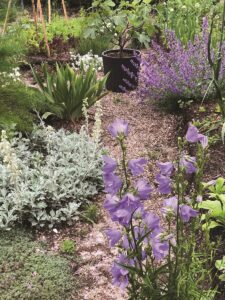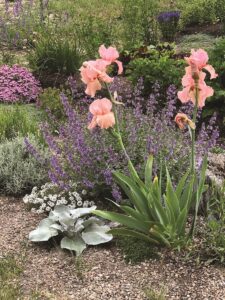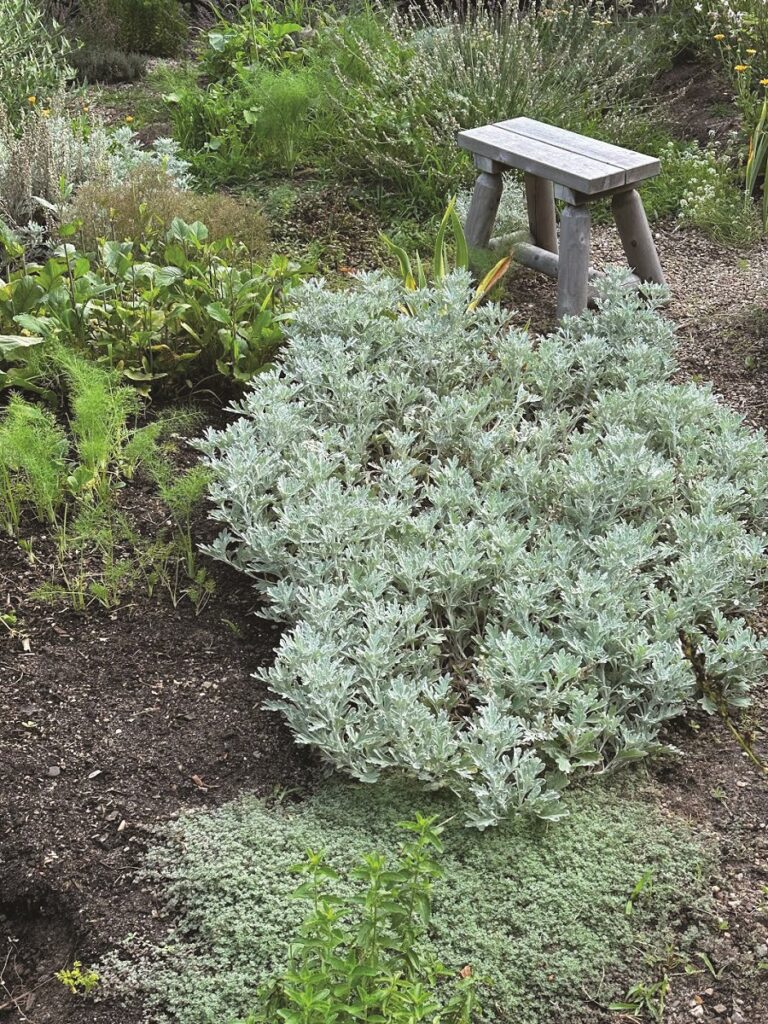A large part of our back yard is a former dog run, which looked fairly bleak when my husband and I first laid eyes on it on a March day several years ago. Even though its most prominent features were cyclone fencing and scraggly junipers, I saw something lying on the still-frozen ground that really got my wheels turning: lots and lots of gravel.
Since I first began gardening decades ago, I’ve dreamed of one day making a garden of plants that would be happy in a layer of silvery pea gravel.

It turns out that I had been collecting mental images of gravel gardens for most of my life. My obsession started early with the front yard of a woman who lived down the street from us in the West Texas town where I grew up. Contrary to all the keepers of trim lawns on our street, Mrs. Ramsey covered her yard in gravel and dotted it with agaves and prickly pears, twisted mesquite trees, and a sequence of seasonal flowers.
There’s something dramatic about the spare simplicity of plants poking up, seemingly at random, through a mulch of stone, and I remember being drawn to the otherworldly beauty of her plantings — so much so that I felt I had to possess some of that beauty. I snuck down early one spring morning to snip all her windflowers (anemones) and a fair portion of her larkspurs, which I hid in our doghouse.
I was quickly caught by my mom, who must’ve wondered what her creative (a.k.a. odd) son was doing in our beagle’s house. She forced me to return the limp stems, which I did tearfully, to Mrs. Ramsey, who I remember only as a shadowy figure in a doorway wearing cat-eye glasses over a grim mouth.
Ever since then, I always try to grow, with varying degrees of success, my own larkspurs and windflowers as a living garden memory.
In the 1990s, I read a book called Derek Jarman’s Garden about the late filmmaker’s seaside pebble garden on the south coast of England. This windswept, austere setting has inspired a generation of gardeners. Jarman used what I call gap-planting, which unlike what you might see in a packed perennial border, relies on the open spaces between the plants for visual effect, much like Mrs. Ramsey’s approach did. And his artful use of found objects has us using driftwood, larger stones, and remnants of silvered locust stumps in a similar way.

Jarman inspired my love of plants that relish being by the ocean. I’ve begun incorporating plant varieties with “maritima” as their species name. Sweet alyssum (Lobularia maritima), the common annual I once noticed growing wild on the sandy sea bluffs around Malibu, may look delicate, but it blithefully withstands drought, heat, and wind here. Others include sea thrift (Armeria maritima), sea kale (Crambe maritima), and our own beach plum (Prunus maritima).
Though I plan to grow as many local natives as possible, plenty of other plants from a variety of habitats enjoy our lean Outer Cape conditions: poppies (especially California poppies), gaura, bearded iris, sea hollies, bellflowers, and even prairie natives like blazing star. I use silver foliage to knit all these disparate plants together visually, including catmint, santolina, and lavender.
One of my favorite “knitters” is dusty miller (Artemisia stelleriana). Our wild version is familiar to anyone who has seen it growing in the dunes, though it is native to East Asia and the Aleutian Islands. A single rooted cutting has turned into several plants that have grown into large, spreading groundcovers over two years. I treasure it as a visual link to the magic that lies just after the hill on the back shore, which is really what this garden is all about: a sense of place.
Long before we put down roots on the Cape, I bought two books by the French author Olivier Filippi, The Dry Gardening Handbook: Plants and Practices for a Changing Climate and Planting Design for Dry Gardens, in hopes that one day I’d have the chance to use them. Filippi, a dry gardening guru, has probably had more influence on me than anyone from a horticultural best-practices standpoint. Because he’s an expert on gardening in a Mediterranean climate, which is not exactly Cape Cod’s, his ideas require some extrapolation. For example, his principle of discouraging irrigation in summer because the moisture rots woody herbs like lavender, santolina, and thyme may not be practical with our summer rains.

My main takeaway from Filippi has been, to borrow a British phrase, a “treat ’em mean and keep ’em keen” planting method. Choose plants that like sandy, infertile soil and a gravel top mulch. Dig a hole. Don’t add any imported soil or amendments, plop in your plant, and resist the urge to fertilize.
I’ve been trying this for the past three years with mostly robust results. Many of the aforementioned varieties as well as sedums, verbenas (both sand verbena and my beloved Verbena bonariensis), certain alpines, and showy tender perennials grown as annuals such as gazanias, arctotis, and blue convolvulus thrive. Others that I thought would be successful, like penstemons, lambs’ ears, geum, rosemary, and certain ornamental grasses, either dwindled under heat and sun or didn’t return after not liking their winter accommodations.
Gardening for me is more about the process and the knowledge I gain from experimentation than the perfect result. I’ll try anything. The space you see in these pictures is an edited slice; anyone who visits our garden will have to squint to avoid some major eyesores: the chain-link that will be carted off someday soon, the ever-present black locusts that seem to pop up overnight, and the weedy grasses that crept in over the gravel once the dogs weren’t running it bare.
Over time, our inherited gravel has become thinned out enough to let weeds take hold, so we plan to get a big delivery of new stones (experts recommend 3 to 5 inches) once we’ve hashed out a design. In the meantime, we spend a lot of time weeding while trimming back the catmints, lavenders, and santolina that have quintupled in size over three years.
Ever the dreamer, I don’t notice the blemishes too much, even though our gravel test plot, about 20 feet square, is surrounded by a larger space of encroaching weeds and locusts. I see it as a utopia, backlit by the soft light of an Outer Cape sunset that gilds each plant edge. I like to think Mrs. Ramsey would approve.
You can follow the writer’s garden experiments on Instagram @steporr.
